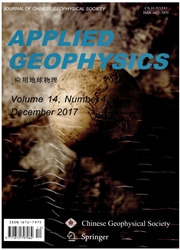

 中文摘要:
中文摘要:
传统Robinson褶积模型主要受缚于三种不合理的假设,即白噪反射系数、最小相位地震子波与稳态假设,而现代反射系数反演方法(如稀疏约束反褶积等)均在前两个假设上寻求突破的同时却忽视了一个重要事实:实际地震信号具有典型的非稳态特征,这直接冲击着反射系数反演中地震子波不随时间变化的这一基础性假设。本文首先通过实际反射系数测试证实,非稳态效应造成重要信息无法得到有效展现,且对深层影响尤为严重。为校正非稳态影响,本文从描述非稳态方面具有普适性的非稳态褶积模型出发,借助对数域的衰减曲线指导检测非稳态影响并以此实现对非稳态均衡与校正。与常规不同,本文利用对数域Gabor反褶积仅移除非稳态影响,而将分离震源子波和反射系数的任务交给具有更符合实际条件的稀疏约束反褶积处理,因此结合两种反褶积技术即可有效解决非稳态特征影响,又能避免反射系数和地震子波理想化假设的不利影响。海上地震资料的应用实际表明,校正非稳态影响有助于恢复更丰富的反射系数信息,使得与地质沉积和构造相关的细节特征得到更加清晰的展现。
 英文摘要:
英文摘要:
The Robinson convolution model is mainly restricted by three inappropriate assumptions, i.e., statistically white reflectivity, minimum-phase wavelet, and stationarity. Modern reflectivity inversion methods(e.g., sparsity-constrained deconvolution) generally attempt to suppress the problems associated with the first two assumptions but often ignore that seismic traces are nonstationary signals, which undermines the basic assumption of unchanging wavelet in reflectivity inversion. Through tests on reflectivity series, we confirm the effects of nonstationarity on reflectivity estimation and the loss of significant information, especially in deep layers. To overcome the problems caused by nonstationarity, we propose a nonstationary convolutional model, and then use the attenuation curve in log spectra to detect and correct the influences of nonstationarity. We use Gabor deconvolution to handle nonstationarity and sparsity-constrained deconvolution to separating reflectivity and wavelet. The combination of the two deconvolution methods effectively handles nonstationarity and greatly reduces the problems associated with the unreasonable assumptions regarding reflectivity and wavelet. Using marine seismic data, we show that correcting nonstationarity helps recover subtle reflectivity information and enhances the characterization of details with respect to the geological record.
 同期刊论文项目
同期刊论文项目
 同项目期刊论文
同项目期刊论文
 期刊信息
期刊信息
